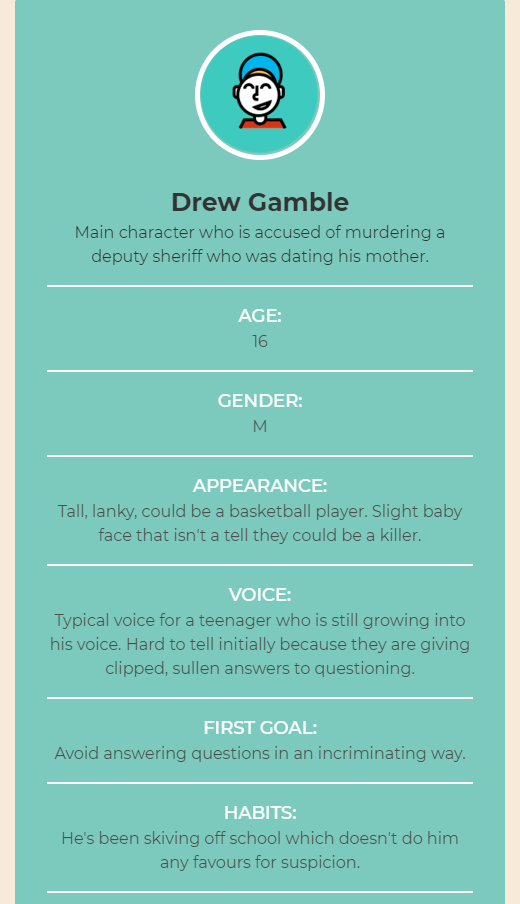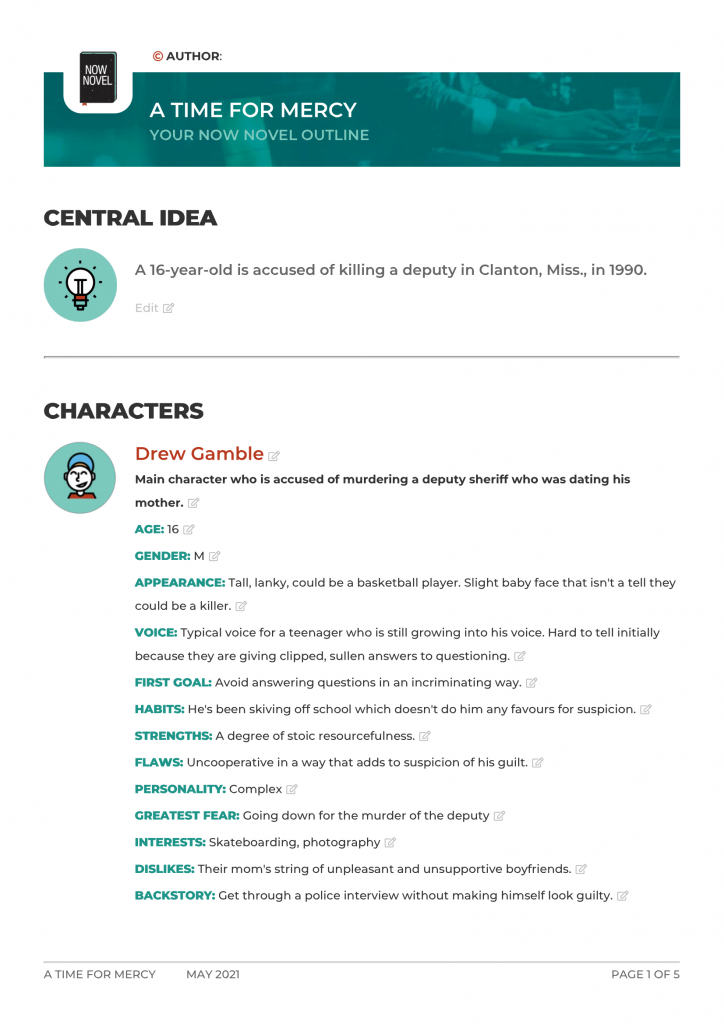Character profiles are helpful process work for writing. A profile contains all you need to know about your characters; ID facts such as name, age, gender, birthplace, plus story elements such as characters' goals, motivations, desires, and conflicts. Read how to write character profiles in 10, simple tips:
First, why should you profile your characters?
In creating character profiles, writers (like detectives who 'profile' suspects) find the puzzle pieces that explain crucial parts of a story, such as character motivations for actions.
The overview this yields helps us understand the full chain of human behaviour, a story's action-to-outcome chain of cause and effect.
Creating character profiles by answering character questionnaires is helpful because you:
- Know enough details about your characters to imagine their actions and driving motivations
- Picture your characters fully enough to visualize how they move, interact, and live
- Pinpoint key differences between characters that help you to build their resemblances and differences, shared values or objectives and disagreements
How to write character profiles: 10 tips
- Draw on your story idea or scenario
- Root character profiles in Goal, Motivation, Conflict
- Use a detailed character profile template
- Imagine core interal and external conflicts
- Try character generators for inspiration
- Brainstorm initial action and reaction beats
- Plan simple, tentpole connections
- Profile your walk-ons, too
- Make contradictions believable
- Expand profile points into scene ideas
Let's explore these ideas further:
1. Draw on your story idea or scenario
Your story idea is the obvious place to mine for a fleshed out cast.
Even a two-line synopsis may inspire a number of main characters, walk-ons and others.
Let's take a story synopsis of a New York Times bestseller as a starting point for creating a character profile:
A 16-year-old is accused of killing a deputy in Clanton, Miss., in 1990.
This is the synopsis for John Grisham's legal thriller, A Time for Mercy (2020). One line alone gives us fodder for obvious characters to profile:
- A 16-year old alleged killer on trial
- The deputy allegedly killed by the teenager
Looking to the scenario in that summary, we could decide to profile further characters.
For example:
- A pro bono lawyer who takes on the boy's case
- The boy's mother who happened to be dating the deceased
- A grumpy, eccentric judge who presides over the case
Some of these character ideas are drawn from Grisham's actual book (in Grisham's novel, the accused's mother was dating the deceased).
When you brainstorm additional characters, look to likely connections. Typical figures such as:
- Likely players for the setting (attorneys, judges, law enforcers in a legal setting)
- Likely allies and adversaries (friends and family, state prosecutors and defenders)
2. Root character profiles in Goal, Motivation, Conflict
A good character profile worksheet will guide you towards understanding 'GMC' for your character: Goal, Motivation, and Conflict.
In the introduction to her book GMC: Goal, Motivation, and Conflict, Debra Dixon unpacks these three important character concepts:
The craft books on my shelves call these three elements by a variety of different names:
Goal - desire, want, need, ambition, purpose
Motivation- drive, backstory, impetus, incentive
Conflict- trouble, tension, friction, villain, roadblockRegardless of what you call GMC, the bottom line is that these three topics are the foundation of everything that happens in our story world.
In other words, GMC is crucial for engaging, arresting character development.
For Grisham's 16-year-old murder accused, the reader will almost certainly ask:
- What was the boy's goal or purpose in killing the deputy (if he was guilty). What is his next goal?
- What's a possible motivation or backstory for the killing?
- How will the numerous potential conflicts (such as unfolding courtroom drama, friction between the boy and his mother who was dating the victim) play out?
Look at your story idea summary [if you don't have one yet, brainstorm one in easy steps in Now Novel's dashboard now]. List a core character's initial goal, motivation and conflict based on this situation.

3. Use a detailed character profile template
A detailed character outline template makes it easy to create a detailed outline for each character.
We can plug the 16-year-old accused from A Time for Mercy into Now Novel's character builder to brainstorm an illustrative character profile example.
This generates an editable profile we can also download as a PDF:

A character profile PDF you can print out and refer to is useful to have.
In the Now Novel PDF you can download from your dashboard, there are links back to your profile that make it easy to go back and edit details as you draft. Change details such as names, interests or backstory at any point.

4. Imagine core internal and external conflicts
Learning how to write character profiles will help you imagine details about characters' lives and personalities that will help you draft more and hesitate less. It's like having a roadmap to a detailed story.
The 'C' in 'GMC' is particularly important when outlining your characters.
Internal conflict supplies tension and thus narrative interest in a character's development. External conflict (conflict between characters and others), too.
As Now Novel coach Romy Sommer says in her webinar on internal and external conflict:
If you know what your characters' conflicts are, then as you're writing - especially if you're a pantser and you don't really plot ahead - just knowing how your characters' pasts and their past wounds are going to affect the decisions they make … is going to help you stay consistent as you write.'
Webinar, 'Internal vs External Conflict: What are internal and external conflict?'
Looking at our example character, the 16-year-old accused, internal conflicts could include:
- Whether to confess to the killing or deny guilt
- Whether to trust his appointed attorney or not
- If he will attempt to destroy evidence or 'face the music'
As you write your character profiles, think about these forks in the road that show the branching possible reactions to conflict.
5. Try character generators for inspiration
There are many ways to dream up characters. Character generators that use A.I. are more sophisticated now than ever.
The website This Person Does Not Exist, for example, is a fun tool to try. The page generates a random portrait photo based on how human faces are mapped out each time you refresh it.
Say you were brainstorming 16-year-old Drew Gamble, to find inspiration for his appearance you could refresh the page until you struck a face roughly fitting this age group:

We could then put this image into our character profile as an avatar:

6. Brainstorm initial action and reaction beats
The above is an an example of how fun creating character profiles can be when you play and explore.
Yet we're writing character profiles for a purpose - to make it easier to find the arcs, the cause and effect, of our stories.
This is why it's helpful to brainstorm action and reaction beats to include in your character profile. 'A leads to B' chains of events based on your story scenario. For example:
| Action | Reaction |
| Taken in for questioning | Tries to give non-incriminating answers |
| Discovers a fellow juror is biased | Decides whether or not to reveal bias |
| Discovers legal client is guilty | Grapples with inner conflict over ethics |
The above examples of action and reaction beats could fit character profiles for Drew, a juror on the case, and Drew's defence lawyer.
List initial possible actions and reactions for your core characters as you profile them.
This will give you an idea of scenes to draft as you expand your profiles into a full story.
7. Plan simple, tentpole connections
As you discover how to write character profiles that are truly useful to your process, you may start outlining connections between your characters, too. For example, a link between the deceased in a murder trial and the suspect's parent (the mother/victim connection in Grisham's book).
As you outline characters and answer character questionnaires, brainstorm entaglements. Some might be evident from the start of your story, while others you could hold back and reveal for a twist.
It's helpful to think of key characters to outline in terms of story 'roles', too. Does your story have character types such as:
- Mentors
- Sidekicks and buddies
- Helpers
- Challengers
- Rivals
- Villains
- Villains' lackeys
Create profiles for any roles you know your story will include due to your genre and/or your initial scenario.
8. Profile your walk-ons, too
Walk-on characters may seem secondary. Yet even if their backstory or favourite ice cream flavours don't make it ito the main story, each detail you know will help you make that person believable. No matter how briefly they appear.
The helpful stranger at the crossroads; the inept substitute teacher; the wildly eccentric shopkeeper - walk-on characters give stories the texture of real life.
Create less detailed profiles for these more minor characters. A name, a location or situation in which they appear, what they want, plus maybe a detail or two of their backstory.
9. Make contradictions believable
In stories, as in life, people contradict themselves. How often has a politician voted against an LGBTQI+ ballot, for example, only to be outed later themselves?
While people are full of contradictions, as you profile characters, make sure contradictions make sense.
It makes inherent sense that a closeted politician would vote against their own interests, for example, if they have internalised fears and phobias and thus a credible reason to publically distance themselves from their truth.
Yet look for contradictions, for example a materialistic character who also decides to give up all their worldly possessions and enter a monastery or nunnery. Unless this pivot is contextualized in the story, it may seem out of character.
The character profiling stage is a good time to pick up on potential inconsistencies in your character arcs that could leave readers scratching their heads.
10. Expand profile points into scene ideas
Once you have outlined your characters and you have interesting profiles with expansive potential, do some drafting.
For example, if we were writing A Time for Mercy, we might draft the scene where Drew Gamble is first questioned by the police.
Moving between an outlining, summarising process and an expansive mode will help you to identify scenes with purpose that connect clearly to your characters' goals, motivations and conflicts.
Profile characters the easy way and start writing now in the Now Novel dashboard.












Thank you so much for this article, Jordan!
Nyra - Over 4 years ago
It's a pleasure, Nyra! Thank you for reading our blog ?
Jordan - Over 4 years ago
The topics have a lot of influence on the way to write for any topic.
David - Over 4 years ago
hi Jordan its so nice talking to you thanks for your tip its very useful i will make sure everyone now about this blog. :)
Zara - About 4 years ago
Hi Zara, it's a pleasure. Thank you for reading and for sharing our blog.
Jordan - About 4 years ago